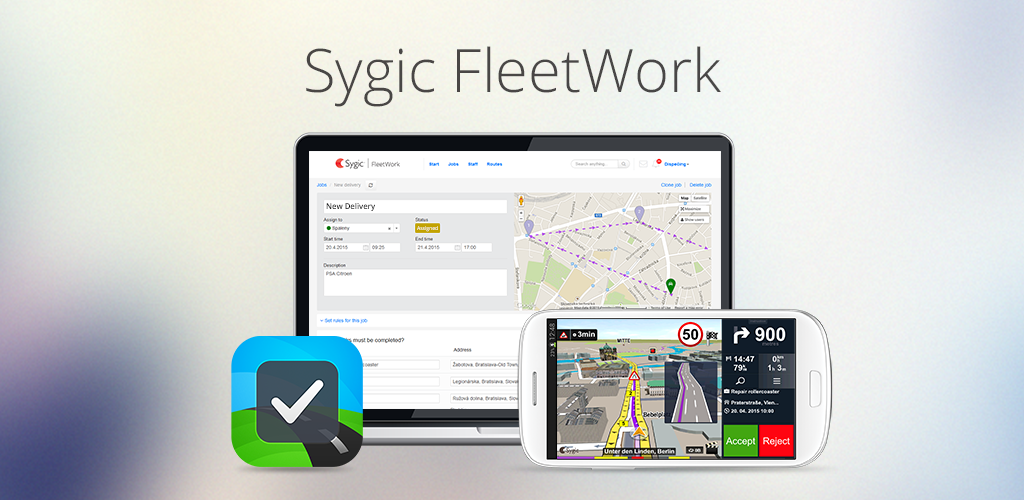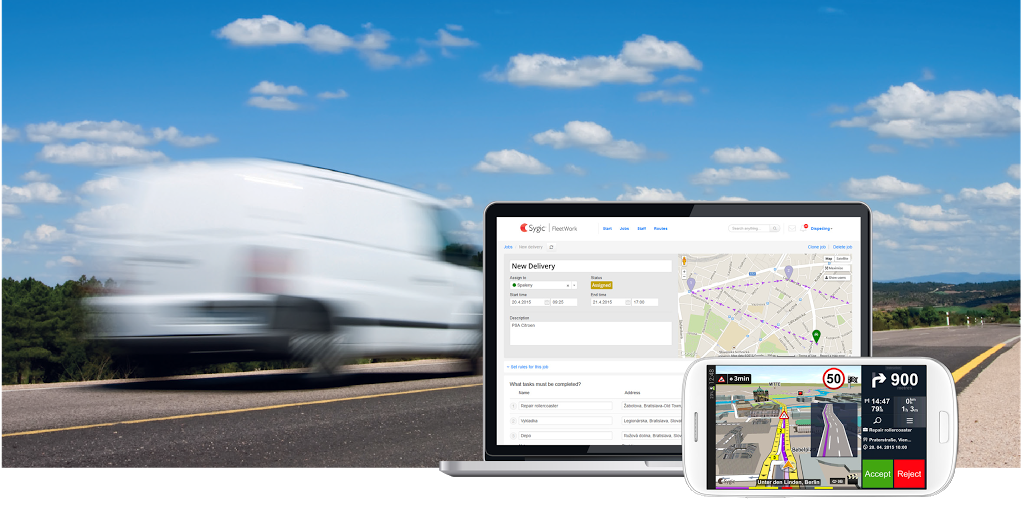Sygic: The future of telematics is open
The effect of the digitalization on the logistics and mobility market has always been very important. As today’s technology advances faster than ever before, the ability to select and adopt a proper telematics solution for your fleet is going to become the biggest challenge in the years to come. We expect that every 3rd successful business model today won’t be there in 2020.
According to Sygic’s expertise, we can see at this moment that industry 4.0 has the strongest influence on telematics solutions providers. In the next five years, we believe that we will see a growing connection between the industry and transportation companies, providing cross-organizational services offered and utilized by all participants in the value chain.
The main challenge for telematics solutions providers is to support the dynamics bridging the gap between industry and the logistics companies on all levels of the supply chain, down to the driver on the road. We believe this is the momentum of the telematics solutions based on cloud for the benefits it can bring to all participants of the supply chain in terms of cross platform flexibility, cost effectiveness, transparency and real-time data sharing.
Keep your fleet connected and open at the same time
In the race to find new successful business models and dynamic strategies for the logistics sector, like 3rd party logistics or transparent logistics, the telematics systems relying mostly on a closed infrastructure start to pose limits.
A modern telematics system able to address these needs has to be open with the ability to integrate tracking and monitoring services from many different sources, and the ability to share information such as position or ETA in real time with the clients.
These are the main reasons why modern telematics solutions are moving towards the cloud, integrating the dispatcher’s app on the web, data storage in cloud, and a mobile application. This flexible combination is able to support any innovation to the business model with a fast deployment of any technology available.
An example of cloud benefits for developers
As a result of Sygic’s very successful experience in the mobile application business, we see from the front lines what impact the vast spread of smartphones and tablets has on the market. Today, every driver has the computing power of server computers from 15 years ago in his pocket. We saw this as a clear opportunity and understood the importance of cross platform solutions that rely on cloud technology for further growth. Being close to the consumers, we have learnt from them that keeping telematics solutions open allows fleets to use this computing power and benefit from efficiencies of sophisticated tracking or order management systems without needing to make big investments in hardware infrastructure or training.
Designing our solution on a Cloud allowed us to deploy a lightweight fleet management system called Sygic FleetWork without needing to worry about investing into infrastructure. Sygic did not have to install any servers to start providing the solution. Moreover, cloud services are reliable, and provide backups and security. We were able to concentrate fully on product development and not on the infrastructure needed. This helped us to dedicate more time to software design and functions in order to deploy Sygic FleetWork quite easily and in much less time. This is a pretty exciting point that teaches us that the industry will be changing faster and with fewer costs than ever before.
Cloud-based solutions such as Sygic FleetWork also allow much faster growth of sales, as this is not drawn back by the amount of work needed to scale the solution. We are ready to offer and sell Sygic FleetWork anywhere in the world and with little investment to satisfy any volume.
Telematics as a service
As a technology company, Sygic tries to simplify the life of its customers with technology solutions. Listening to the needs of fleets already using and solution providers integrating our Professional Navigation product, brought us to understanding of the importance of cost flexibility in the logistics. The winning business models of today often rely on contractors being able to satisfy peaks in demand or special requests of the final customer. A solution provider has to mirror this trend with an open product able to integrate tracking and monitoring services from many different sources.
An open, cloud-based telematics system combined with the bring-your-own-device strategy allows transportation companies to benefit from an efficient 3rd party logistics management in no time. Parcel delivery companies on the other hand, can easily start sharing the data from the driver directly with their partners or clients, achieving greatest possible transparency in real time and better service.
The biggest benefit for customers is that the learning curve for the solution has been reduced. The end user can start using the solution without needing to have some IT person install the solution first. For example, you can start using Sygic FleetWork within 5 minutes after registering for a free trial. All you need to do is download the application and then log in. This also helps to keep maintenance costs on the customer side low. The same applies for your contractors as well.
Cloud technology is transforming telematics systems into software-as-a-service business by providing all its benefits. Today you can dispatch and monitor your driver within 5 minutes after installation. If you don’t like how your system works or if you are missing some functionality, then simply cancel the service, or simply add different functionalities like GPS Navigation with just one click.
The future
No one really knows where technology will bring us next, but it’s clear that advancing technology needs to be supported with legislation to allow markets to benefit from its full potential.
Talking about cloud-based solutions for logistics companies, the major bottle neck is represented by connectivity limits, and elevated roaming data costs in Europe. To have a real-time overview of your assets and employees anytime, they need an internet connection anytime, anywhere.
For example, the Sygic FleetWork solution needs to send anywhere from 80 to 400 MB of data a month including pictures attachments and real-time traffic information. If we imagine that these data could also be sent within a regular data plan when abroad, this will not only reduce costs for users significantly, but allow solution developers to explore new functionalities that require even more data transfer.
What will really bring telematics solutions to the next level is LTE or 4G connectivity. Allowing transfers of large quantities of data in a short time opens doors for solutions that allow not only tracking, but a real-time view of the situation on the road, and more detailed monitoring of drivers’ behavior with the ability to influence it remotely.
About the Author:
Martin Strigac – Director of Sygic Business Solutions, oversees all Sygic B2B activities globally, exploring future business models, R&D and product innovations and strategies for major business partners and projects. Martin has been managing IT divisions and large software projects for leading global companies like Siemens, Citigroup or Asseco Group.





